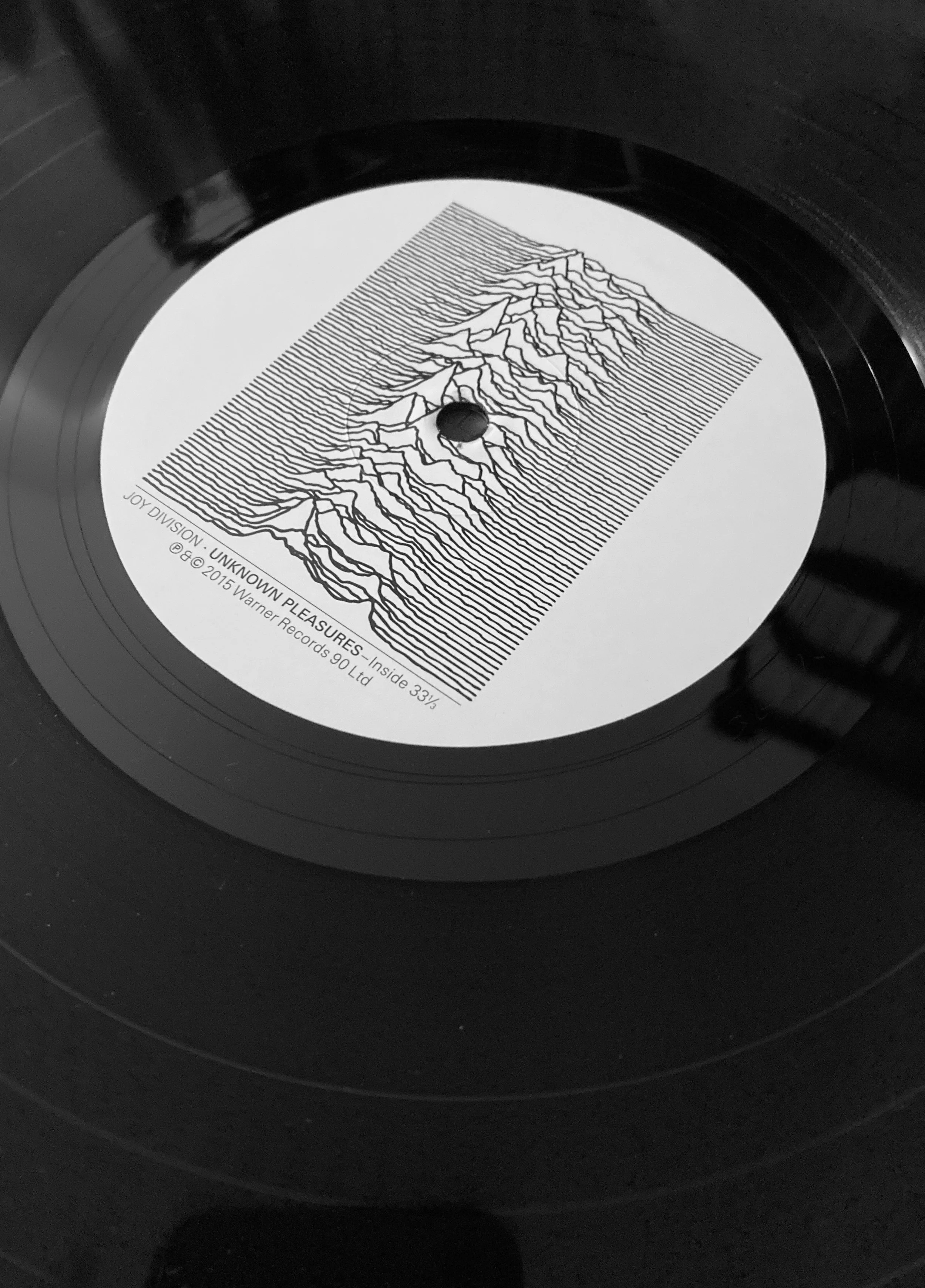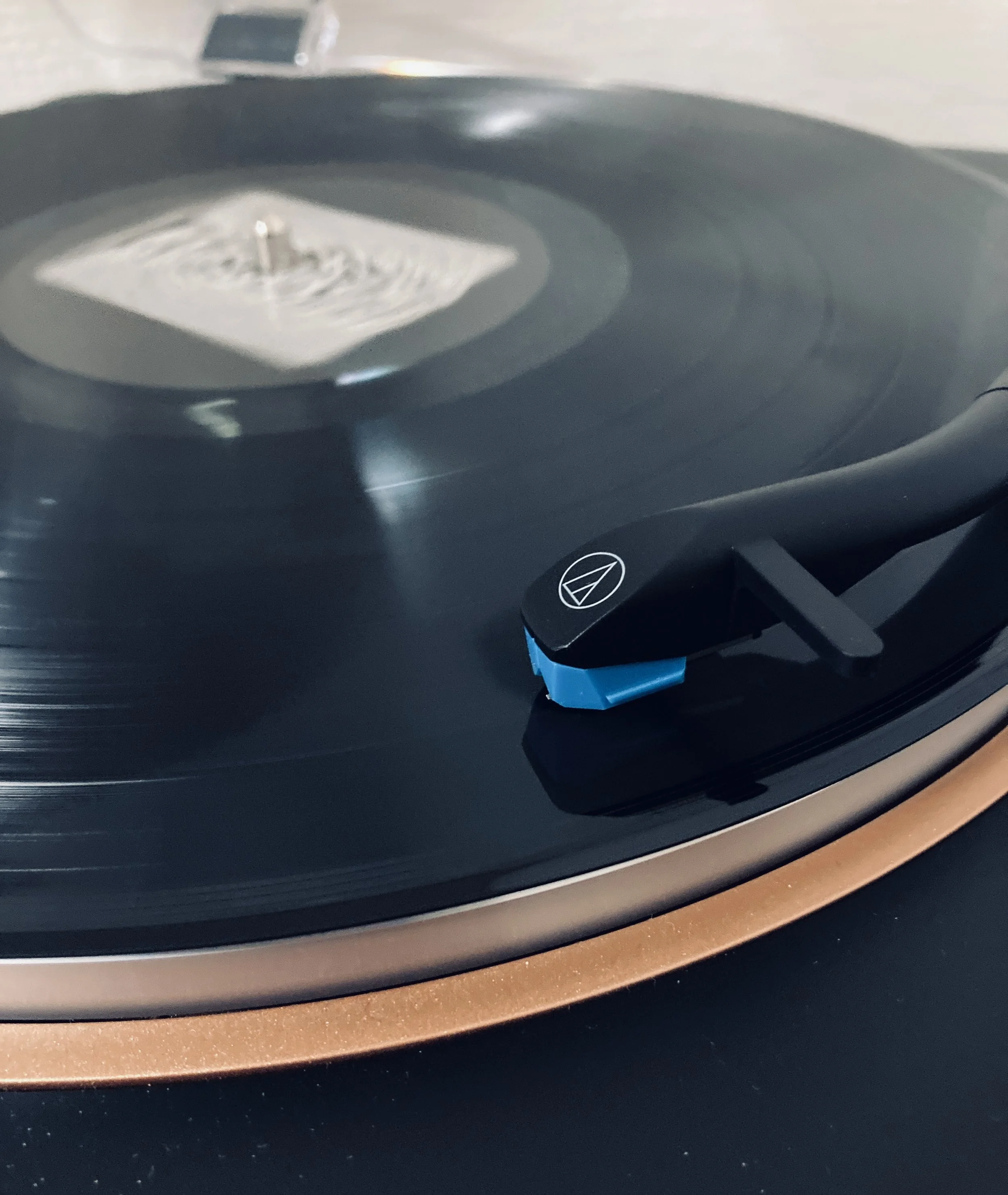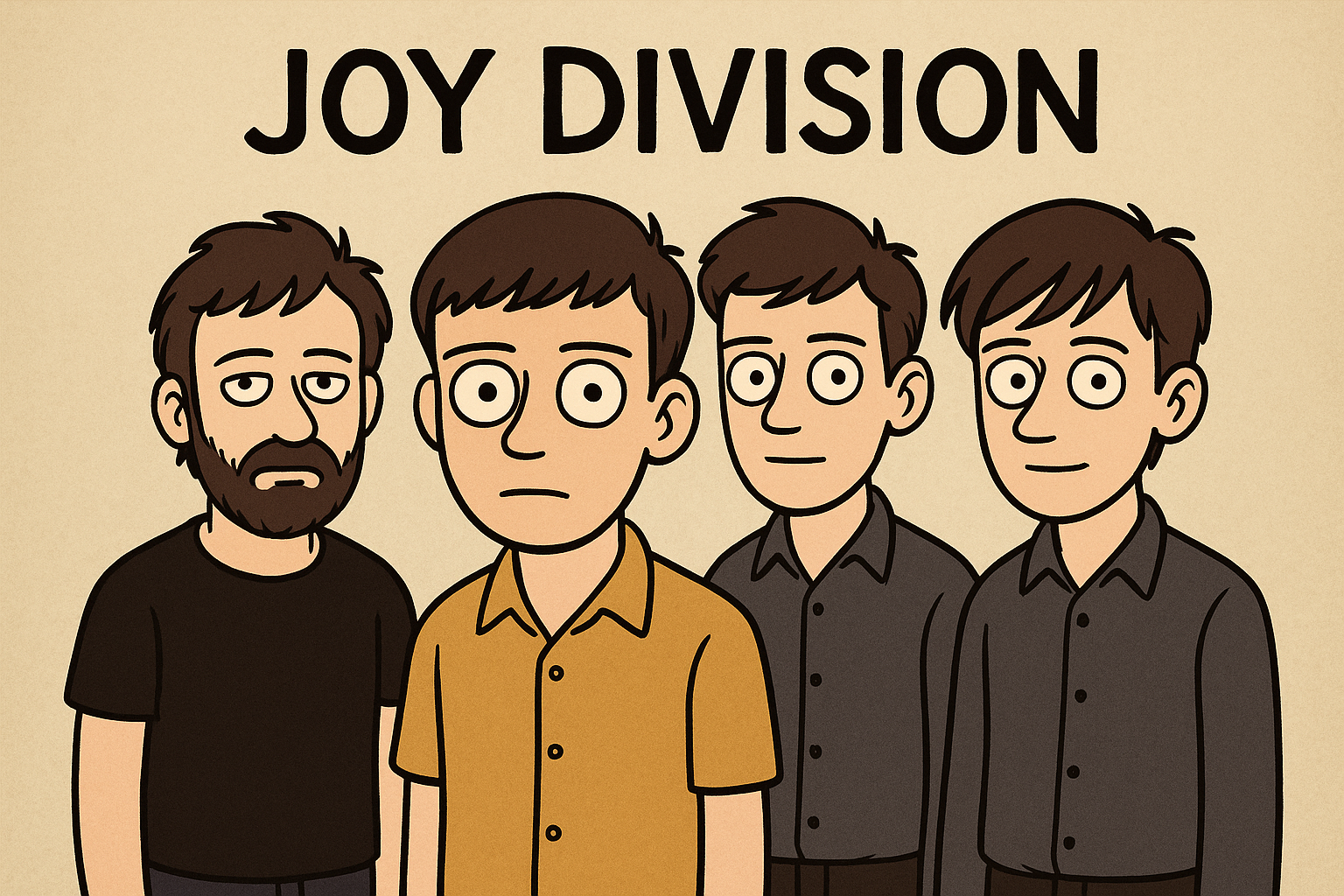JOY DIVISION - “UNKNOWN PLEASURES” REVIEW
I recently bought this iconic album on vinyl and, despite forty-five years of familiarity with it, I suddenly felt I wanted to review it from not only the perspective of a long-time fan, but also that of a song writer and audio engineer.
First, let’s get the basics out of the way. You know the album artwork, even if you’ve never heard the music - a graph of a radio telescopic observation of a pulsar.
Joy Division were initially a grimy northern punk band hailing from Salford / Macclesfield, but shortly before this album was recorded (1979) they discovered ‘space’ and experimental restraint, aided by maverick producer Martin Hannet who had been involved in the development of digital reverb, with which this album is drenched. A post-punk classic was born: jagged, glacial, unforgiving musical backdrops with added unearthly dissonance, the hum and swoosh of early synths and vocalist Ian Curtis’ off-key deep poetic ruminations combining to produce something pretty unique and ground-breaking at the time.
We all know how it ended, too : Curtis committed suicide a year later after the recording of a second album, “Closer,” the surviving members going on to form New Order.
Part of what makes the recorded output of Joy Division stand out is the happy coinciding of the original talents of the band, the aforementioned production techniques of Martin Hannet, the stunning sleeve designs of Peter Saville and arty Manchester label Factory Records releasing it with naivety and zero promotion.
I’m going to run through each of the album’s ten tracks, but first some general words about the thing as a whole.
I’ve already mentioned the contribution of digital reverb to the overall vibe, something on the whole very positive, although I would dare to say that it was slightly overdone - in fact, Hannett committed the sin of putting reverb on the bass drum, which does tend to muddy it a bit (rock music prefers a more biting, atacking sound).
Let’s talk about the musicians involved. This is another thing that made Joy Division stand out - and I’m not really talking about virtuosity here. Bernard Sumner, the guitarist, as a player is rather poor from a technical view point. Look at some live performances on YouTube and you’ll see his constant fumbling, bum notes and wrong chords all over the place. But - his skills at composing minimal but highly effective riffs is second to none. Ditching a lot of punk’s power chords he opted for two-string motifs, repetetive rhythmic phrases and plently of silence.
Peter Hook, the bassist, still doesn’t get much recognition in muso circles, but his playing is unique. Aggressive, distorted and frequently playing chords and taking up the melody line high on the neck - completely at odds with conservative bass doctrine.
Stephen Morris, the drummer, again providing innovative ways of playing : repetetive rhythms, ultra-fast hi-hat work and dabbling with drum machines and electronic percussion.
And of course, Ian Curtis’ deep and somewhat disturbing voice.
Which reminds me of my own history with regard to Joy Division. Like many kids at the time, I was an avid listener to John Peel’s BBC radio show from about 1978, so I was familar with the band, but in truth I found it too uncomfortable to listen to. I preferred more ‘standard’ punk rock initially, and it took me some years to get into and appreciate the more arty experimental aspects of what would now be called post-punk. In short, Curtis’ voice and lyrical content were too much for the thirteen year-old me to handle. However, this didn’t stop my own fledgling band from stealing the bass line to ‘Transmission,’ a later Joy Division single, and also being gutted when I heard the announcement of his death live on air. I knew I had to get into this band eventually, and the catalyst came in 1984 when I moved to Manchester to attend university. Walking the same streets as the band, the time and place were right, and I can still remember the amazement as I heard the opening track from “Unknown Pleasures,” a vinyl copy of which my sister had bought me for my birthday.
Now let’s look in more detail at the individual tracks. Bear in mind that my overall opinion of this album is the same as most other people : it’s one of the greatest of all time, although there are caveats.
SIDE ONE
Track 1 : DISORDER
The album opens with an uncharacteristically speedy tempo, but this track is no holdover from Joy Division’s punk days. All the elements that mark this new post-punk phase are present: a synth whoops randomly in the background, the guitar plays minimal scratchy riffs over a frantic distorted bassline. The song has no chorus, only verses and a coda. And oh yes, dissonance - which matches the song title well. Listen to the bassline: like many JD songs, Hook plays basically the same thing all the way through, but with variations. The main riff is in the key of Eb and centres around the notes Eb, G and Bb - but when Sumner plays his guitar solo parts, Hook briefly throws in a low E natural, which is just plain wrong and totally off - and yet it works, and adds to the overall feeling of disquiet. Sumner and Hook were novice musicians, and with their cheap equipment they most likely couldn’t hear too well what they were actually playing - their parts are littered with examples of unorthodoxy like this. Probably unintentional, it only enhances the mood. At the end of the track when Curtis starts shouting “I’ve got the spirit but lose the feeling,” Hook again lets intuition rise above the shackles of strict music theory and starts playing a two-note glissando echoing the singer, but the notes of which have drifted away completely from the key of Eb, which the guitar is still adhering to.
Overall a superb, flawless track in both both composition, execution and production.
Track 2 : DAY OF THE LORDS
This would be one of my two favourites from the album, although I suspect I’m in a minority on this one. Slow, menacing and ominous, Hook sticks to the low end of the bass for once, while Sumner plays repetetive riffs with drone notes adding to the suffocating, confined feel. This song actually has a chorus, the disturbing “Where will it end?” call of Curtis, which gets more and more strained as the song progesses, and is backed by a thin, plaintive synth which is a standout moment of glacial beauty. It’s always hard to pin down exactly what he is singing about, giving Curtis’ penchant for poetic vagueness, but the doom and gloomy vibe is unmistakeable. A superb song.
Track 3 : CANDIDATE
Now we get into fully experimental territory, a much more abstract and less-structured side of the band that really appeals to me. Slow-paced and empty, Candidate consists pretty much solely of a bass part featuring chords against a loping drum groove of mostly the kick drum and constant ride cymbal. The guitar is barely recognisable as such, and merely provides occasional bursts of disjointed atmospheric noise. No chorus, and it all just abruptly ends after a couple of minutes. An excellent slice of atmosphere.
Track 4 : INSIGHT
The experimentation and distancing from rock norms continue on this track. It begins with a reverb-drenched recording of a lift, harsh, mechanical and metallic, before the song fades in. For the entire track Hook plays an open D drone string on his bass against a slightly dissonant melody on the G, while the drums play a slow chugging rhythm punctuated with ‘disco’ synth drum hits, and the guitar - well, it’s so smothered in effects and back in the mix, who knows exactly what it’s doing. Curtis’ vocal, ruminating on remorse and regret, sounds distant, almost as if recorded over the telephone. The song explodes unexpectedly in the second part, the drums all rapid-fire kick drum, cymbal and synth percussion, while the bass, still rooted to the D drone, plays a mechanical riff on the 19th fret of the top string - absurdly high for a bass. Another wonderful track, although it has to be said that the synth drum hits have not dated too well.
Track 5 : NEW DAWN FADES
We round out the first side of ‘Unknown Pleasures’ with what for me is the best song of the album, not to mention a contender for best Joy Division song of their entire output. Slow, stately, dignified, graceful and yes, beautifully melodic, this is an epic anthem indeed. Beginning with some backwards tape loop of something or other, the slow drum beat kicks in before Hook joins with his iconic yet simple descending bass line of E, D, C, A which he keeps up with minor variations throughout the proceedings. The guitar joins with a low, mournful melody picked out in slow single notes, perfectly harmonizing with the bass (a rare example of when guitar and bass were actaully listening to each other?). When Curtis joins in with a softer, more restrained vocal, the guitar switches to glacial chiming arpeggios, subtle yet devastatingly beautiful. The initial reflective lyrics like ‘a chance to watch, admire the distance,’ however, also contain the disturbing line ‘a loaded gun won’t set you free - so you say.’ As the song proceeds, Curtis becomes more and more impassioned, until he’s really belting it out in desperation at the end - ‘I’ve walked on water, run through fire, can’t seem to feel it anymore.’ An astonishingly great track.
SIDE NOTE: A couple of years ago I accidentally stumbled upon the ‘inspiration’ for Sumner’s guitar intro to this song, and it’s quite surprising : Black Sabbath!!! Check out the final minute and a half of ‘War Pigs’ from the 1970 album ‘Paranoid’…sounds pretty familiar, huh?
SIDE TWO
Track 1 : SHE’S LOST CONTROL
The second side of the album opens with what for many people is a JD favourite : the jarring, dissonant threnody to epilepsy, the disease that afflicted Curtis and contributed to his decline. I love it too, but I believe this version to be flawed. There’s a reason the band re-recorded it later (released with ‘Atmosphere’ as a single). First let me describe the song as presented here. It begins with an iconic Steve Morris drum groove, machine-like in its precision and sonically odd with the use of electronic percussion and the snares removed from the snare drum. The bass enters, once again employing a drone on the D string with a descending melody picked out on the highest frets of the top string. It’s immediately arresting as one of the notes, a Bb, is off and resonates inharmoniously with the droning D creating tension. The vocals enter, echoing and disembodied, and finally power chords and a second bass line are added to the mix. It’s this second bass part that spoils it a bit for me, making for a very muddy sound. The later version, recorded in 1980, I believe, is much brighter in tonality, with harder-hitting drums, cleaner bass and guitar, and the addition of keyboards and an extended coda with additional lyrics. The ‘Unknown Pleasures’ version is still a great song, but I think once you’ve heard the other take, you won’t be able to go back…
NOTE FOR OBSESSIVES : This second recording of ‘She’s Lost Control’ is actually available in different mixes. The one on the ‘Atmosphere’ single has more prominent and longer keyboard parts and a fade-out ending, while the mix released on the ‘Substance’ compilation has a shorter keyboard part and doesn’t have a fade-out. The former is the better mix, in my humble opinion.
Track 2 : SHADOWPLAY
Another fan favourite, and indeed it is an excellent early example of the JD ‘formula’ - a repetetive bassline (a riff based solely on C, D and a low E is played throughout), low-key guitar work, and a steady drum beat with a synth drum employed instead of a crash cymbal. Sumner actually has no less than two guitar solos, quite ‘rock ‘n’ roll’ for Joy Division, but they are tasteful and fairly minimal. A suberb song of urban alienation.
Track 3 : WILDERNESS
A rather over-looked track, but I really like this one. The music for the most part hearkens back to the more conventional sounds of early JD, with a main riff consisting of a simple three power chord motif, although the drums feature an unusual lilting groove enhanced with echo. There’s a nice minimal guitar break, but it’s the lyrics which made the track so evocative for me, full of bleak religious imagery transporting us back into history.
Track 4 : INTERZONE
And this is where the album dips into mediocrity, albeit only for the brief two minutes taken up by this slight track. Many people seem to like it, but the moment I heard it, I felt it didn’t belong with the other tracks. Indeed, ‘Interzone’ is a remnant of an earlier phase of the band, and it shows. It’s a fast, simple rock tune with Hook taking the lead vocal and Curtis following him in a pointless and ineffective ‘call and response.’ Looking at the song’s origin explains why musically it sounds nothing like the rest of the album : in 1978 the band signed to RCA records and recorded a really bad-sounding album which they hated, and had to buy their way out of the contract. Part of the deal was RCA trying to get them, bizarrely enough, to cover the 1972 soul track ‘Keep On Keepin’ On’ by Nole Porter. They couldn’t or didn’t want to do that, but they did nick the main riff and use it for ‘Interzone.’ Even the lyrics feel shallow on this rare JD dud.
SIDE NOTE : In my opinion, in all of Joy Division’s 45 or so released songs, there are only three that are fairly crap, ‘Interzone’ being one. The other two are ‘Failures’ from their 1977 debut EP ‘An Ideal for Living,’ and ‘Novelty,’ the B-side of 1979 single ‘Transmission.’ The former is a fast, punky song with some seriously awful attempts at rock guitar solos from Sumner, while the latter is another very early song with lyrics written by Hook, and no ammount of sheen from Martin Hannett’s production can hide how un-Joy Division it sounds.
Track 5 : I REMEMBER NOTHING
We have arrived at the final, longest and perhaps most experimental track on the album. I think this is superb, although I’ll admit it’s an acquired taste, even for JD fans. The song is barely a song at all, rather it’s a six-minute slice of ambience with a minimal funereal drum beat, synth drones, a one-note bass line, some clicky muted guitar atmospherics and a lot of breaking glass. Over this, Curtis, sometimes woefully off-key, shouting out ‘we were strangers’ and a few other phrases. Somehow it works, and it works brilliantly. Creepy, scary, dark and mysterious, it is really the perfect track to end the album.
CONCLUSION
An amazing, ground-breaking album that started a host of new music styles, such was its inventiveness and subsequent influence. It’s a coming together of unlikely talent that was spawned from the ruins of punk but, once the battering ram of that genre had kicked in the gates of the musical establishment, burst forth into new realms of experimentation. And that was what punk was all about, after all : do anything you want, there are no rules, let your expression break free of conservative constraints.
It isn’t perfect, though. The sessions that spawned this album also produced another six or seven tracks that were released on samplers, compilations or elsewhere, and almost any of these would have fit better than ‘Interzone.’






